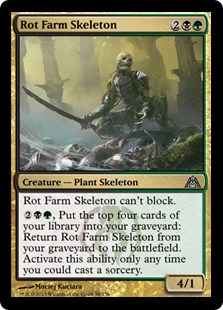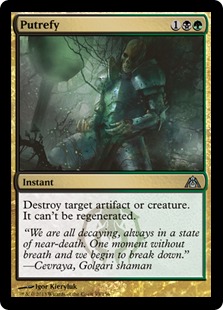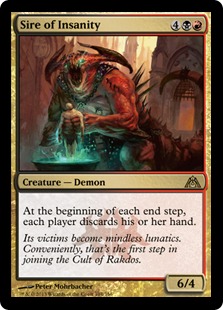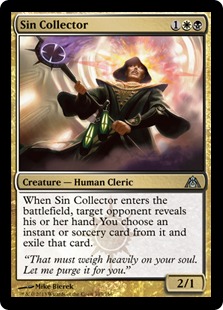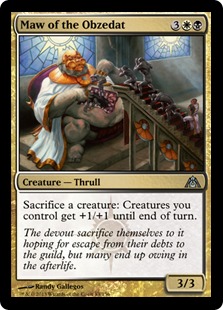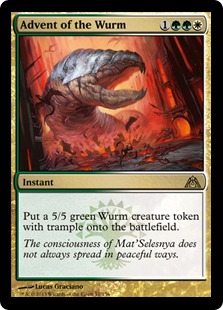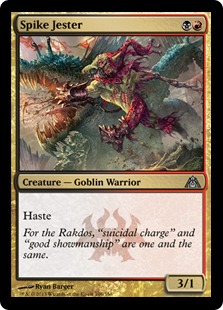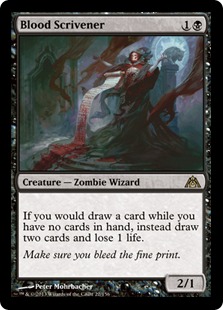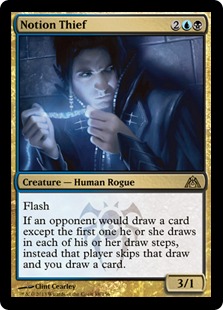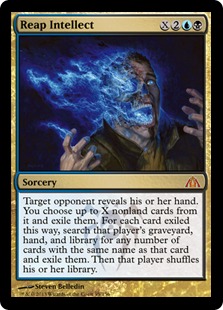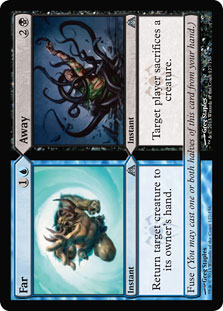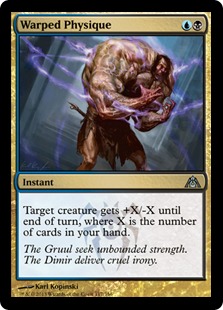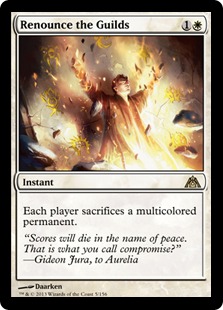It’s been a long time since I’ve written a set review. The old style of writing about every card, complete with alternate flavor text, was great fun for both me and the readers, but it was also a huge amount of work and would overlap quite a bit with what others are up to. Instead, I decided to explore a different path and go over the set from a series of more narrow perspectives. How do things look from the standpoint of each of Standard’s well-oiled machines? How do these cards change the game?
Reanimator
Reanimator players find themselves with good news and bad news. The good news is that no new cards are serious threats to Reanimator’s strategy. There are a few cards that could make aggressive decks slightly faster, such as Blood Scrivener, Spike Jester, Pyrewild Shaman, Rubblebelt Maaka, Voice of Resurgence, and Viashino Firstblade, but that’s as bad as it gets and none of those cards line up in a dangerous way.
Crypt Incursion is the only explicitly hateful card in the set, and if players are taking out Tormod’s Crypt to put this in, that makes you happy rather than sad. Things are likely to get slightly worse, but mostly it’s business as usual for you if you want it to be. Business has been very good for some time now, and it’s more about what the new incentives do to the surrounding decks.
If there’s one card that sticks out as potentially useful, it’s Rot Farm Skeleton, although it’s doubtful it can be more than a sideboard card. Ready // Willing offers a lot of upside if and when fights occur, but it’s not clear that this is better than having more haymaker creatures, which the deck is already not playing that many copies of. Anything from Dragon’s Maze making it into the maindeck would be a surprise.
U/W/R Flash
These decks are very much not my style of play, so it’s hard for me to say how they will adapt. In theory, there’s a new planeswalker in Ral Zarek, but my opinion of him is very low. The good control civil war weapons mostly went to other colors, but it’s doubtful things will get appreciably worse than they already are in that department.
The deck does potentially pick up Aetherling and can somewhat justify Cavern of Souls. This could be the new route to victory, and the ability to get aggressive with it pairs well with much of what the deck can run. It’s another way to exploit power amplifying effects since it can get up to eight power, allowing a kill in one turn or a massive life gain, but getting him into play is awkward and the deck very much doesn’t want to play what is effectively a seven-drop. Thundermaw Hellkite and Aurelia, the Warleader are expensive enough as it is, and no one’s looked twice at Angel of Serenity, so this would at best be a sideboard strategy. But Aetherling is at least a big upgrade to options of that nature if Cavern of Souls can be involved.
The ability of U/W/R to turn aggressive will be rewarding for it as it faces people who are newly tempted by expensive cards, so in addition to the Aetherling option I’d be looking to build as aggressively as possible and would not be surprised to see the return of Geist of Saint Traft, Thundermaw Hellkite, or even Boros Charm. By contrast, trying to play a control game with only a few counters or trying to counter the uncounterable against decks that are packing expensive anti-control cards is a losing battle for U/W/R. The best way to fight back is to kill them and to get ahead on the board, and people will tend to play greedy or unsound strategies early in a season—both also encouraging aggressive cards and play.
This was already the way I’d have been looking to go, however, so it is possible that I’m biased by my natural way of deckbuilding, which tends to result in making this type of deck cry if it doesn’t move to end the game rapidly. Others may not take the same approach.
Jund
None of the new tools are especially threatening to Jund, as you have good tools to answer all of them, but your 75 doesn’t have enough room for all the answers you seek, so you have to prioritize. There are also new cards demanding room. You get to swap out Murder for Putrefy, which is a pure win. Sire of Insanity is an excellent card that reinforces the type of game that Jund wants to play, especially if it can be made uncounterable, and the opponents who will face that plan don’t especially want to be playing cards that stop it from working.
The cards that stop Rakdos’s Return are Witchbane Orb, counters, and Duress—none of which stop a Sire of Insanity with a Cavern of Souls—and both require the answer to be there right away. Opponents have been able to count on Witchbane Orb, and Sire makes that much less of a problem, as does Putrefy. If you’re willing to give up Rakdos’s Return for Sire of Insanity, Possibility Storm[/author]“][author name="Possibility Storm"]Possibility Storm[/author] is another interesting choice for after sideboarding when you could bring it in for matchups where you don’t want removal. In those situations, suddenly you get to play your cards for full value while your opponent’s situational spells stop working.
Jund thus looks like a big winner, as it gets powerful new weapons against control and a major card upgrade in Putrefy without taking on especially problematic new enemies. You have discard to put pressure on Aetherling and finish games quickly, so while that card is quite good it doesn’t seem scary. A resurgence of Jund seems likely.
Mono-Red Aggro
The decklist is already tight, making it tough to justify adding new cards, and most of the set is multicolored. You’re realistically not looking at anything other than Pyrewild Shaman and Rubblebelt Maaka, and neither seems good enough to replace what’s already in the deck. The good news is that the upgrades other people are making don’t matter much to you either, so it’s more about hoping the metagame breaks in a way that leaves people vulnerable. You’re hoping people will play tons of copies of Aetherling and let you into matches, but you’re also terrified that Aetherling will discourage decks that you can beat up on.
The Aristocrats
Sin Collector is an obvious fit and will almost certainly be a key part of the package designed to break down control decks, with the question being whether you go for Sire of Insanity or not. Like many anti-control cards, it is probably bad too often to maindeck but fits right into your sideboard since it’s important to not have all your anti-control tools cost four and five mana. Possibility Storm[/author]“][author name="Possibility Storm"]Possibility Storm[/author] isn’t impossible there either, as there are configurations where you shrug it off and you can hold back cheap cards once you know it’s coming. There’s also a new potentially interesting sacrifice outlet in Maw of the Obzedat. It’s likely not high enough impact to justify paying five mana, but it’s worth keeping in mind just in case.
None of the new expensive cards pose a challenge to your strategy you haven’t seen before other than Aetherling, but that card could potentially be a serious issue because it kills you while putting a large dent in your clock. The general plan against control involves grinding them down, but now you have a much more serious worry about being taken out and hammered into the ground faster than you can make things happen. The threat forces you to become more aggressive.
The bigger issue is that the removal spells available are far more hostile to the permanents that you thought were safe. Enemies now have two mana spells available that can kill Falkenrath Aristocrat or Obzedat, Ghost Council without needing assistance from a board sweeper, including Warped Physique and Renounce the Guilds, which means that trying to avoid losing to both targeted removal and global removal is getting even harder. The good news is that all those cards are taking slots in someone’s 75 that previously were doing similar things, and those players were already choosing their cards with an eye towards The Aristocrats creature set. But the world is likely far more hostile than it was before, and the new cards you get don’t offer much in exchange.
Bant Control
Bant wins big if it can make the mana on Aetherling work, potentially a big upgrade over Prime Speaker Zegana, although I don’t see how to get that, Cavern of Souls, and Kessig Wolf Run in at the same time, which is a pity. Still, this provides the ability to go on the offensive without opening yourself up to Supreme Verdict or even fringe players like Terminus or Merciless Eviction and punishes people who think the worst thing you can do if they tap out for one of those is that you’ll cast a Sphinx’s Revelation.
You also get access to Plasm Capture and Advent of the Wurm if you want them. These create a glut of good four mana options but also a dilemma for the opponent, forcing them to choose which card to walk into. Bant is in the best position of anyone to play these haymaker games going forward.
Naya Blitz
Much like Mono-Red Aggro, Naya Blitz doesn’t care about the new set unless it wants to try Voice of Resurgence or possibly a Tajik, Blade of the Legion. Warped Physique is bad news for you due to efficiency, but Putrefy is likely good news for you because it comes with side benefits you don’t care about even though it makes removal better in general.
Human Reanimator
This deck has fallen out of favor. Sin Collector fits right into the plan, but sideboarding in that direction reduces space available for other plans. Transforming into a bad Thragtusk deck might have been good enough for a while, but people can handle it now. Playing two-thirds of your games (when they count) with a bad version of your deck (even if it’s superficially a good matchup for the deck) catches up with you once your opponents stop over-sideboarding and blowing themselves up. The side where you need better Humans, they’re not available.
B/R Aggro
Spike Jester and Blood Scrivener solve the two-drop problem this deck has struggled with. Spike Jester is exactly the stats and abilities you wanted, and Blood Scrivener is a Zombie, so you can now play the curve as low or as high as you want.
One of your best assets was haste, which Spike Jester reinforces, and falling behind was the place where the deck was weakest—the solution to which is to not fall behind! At the higher casting costs, you already had good choices, although Sire of Insanity may be helpful at six if you’re willing to go that high.
Esper Control
Esper gets the longest section by far because it is the deck that cares the most about its enemies and therefore rises and falls in popularity. My point of view on Esper has always been that it is a terrible deck that has been extremely well positioned.
Esper punishes players for playing cards that either don’t do anything meaningful to the Esper player or don’t do enough to avoid having to commit three or more cards to the board and walk into Supreme Verdict or other sweepers, and it punishes them hard. Every global removal creature spell like Supreme Verdict, every instant removal spell like Ultimate Price, every burn spell like Searing Spear, every utility creature like Skirsdag High Priest is one more card that isn’t quite dead but that can usually be ignored. In some versions, this goes as far as “everything that goes after nonland permanents period.”
Esper rises and falls based on how tempted players are to play lots of those cards or otherwise play cards that don’t cause Esper trouble. Esper also has to worry about a large and growing number of cards that do cause Esper big trouble, and that’s the big thing Esper players are going to have to adjust to: they now live in considerably more interesting times than they did before.
Aetherling is the first card that pops out. This is something that Esper players simply can’t interact with because it’s an essentially unstoppable card. It can attack for eight damage a turn, while the best an answer can do is force it to go away for a little while. Azorius Charm will buy you one turn, but Supreme Verdict doesn’t even slow it down. And on its own, it’s enough that Sphinx’s Revelation can’t gain enough life to keep pace. How do you deal with this being played off of a Cavern of Souls?
Then there are two other six-drops that are here to cause big trouble: Sire of Insanity and Ruric Thar, the Unbowed. Ruric Thar isn’t the end of the world, but it’s going to cost you six life unless you have Angel of Serenity. However, Sire of Insanity is the true nightmare. There aren’t many good responses, especially if Cavern of Souls is involved, and if you discard your hand and have to discard it again every turn, your chances of winning become very low. Devour Flesh and Far // Away are decent responses, but Esper has many demands on its card slots and suddenly has a very serious issue if it has to tap out for a board sweeper.
Also around to make trouble are Voice of Resurgence, which is highly hostile to your game plans on several levels, Rot Farm Skeleton, which can be dealt with by Detention Sphere or Dissipate but is another way to lose otherwise winnable games, and the deadly Notion Thief, which makes it very dangerous to try to cast Sphinx’s Revelation into a large enough amount of mana. Even Sin Collector isn’t good news since a Human creature that can serve this purpose allows people packing Human Reanimator and/or Restoration Angel to make a whole new brand of trouble.
In theory, Pyrewild Shaman could give red decks more long game than you’d like them to have since the long game plan involves letting them nibble at you, although that type of plan is usually underwhelming. There’s even Possibility Storm[/author]“][author name="Possibility Storm"]Possibility Storm[/author], which makes everything the Esper deck does stop working right. Reap Intellect is also around, which means that if you resolve a big Sphinx’s Revelation on your turn, it could mean you lose rather than win as the enemy takes apart your entire deck, and against Bant decks there’s the new worry of losing the game to Plasm Capture.
There’s also the issue of Advent of the Wurm, which could allow some types of aggressive decks to play the later turns of the game on the Esper player’s turn if used in combination with other similar effects and encourage Rootborn Defenses, likely inspiring an update to Delver of Secrets decks to raise their curve slightly and lean even more heavily on the populate mechanic. Aggressive decks that don’t have to tap out are problems if they can respond to sweepers in positive ways. In this case, that starts with Rootborn Defenses or letting the Supreme Verdict happen and then picking up a 5/5 which can then be pumped up and potentially could include Voice of Resurgence.
That’s a lot of new ways to get into nightmare situations and lose. People could make it very hard out there for a control player. What compensation has been offered? There are six cards that an Esper player could reasonably want. Two of them are part of the control player civil war, as Notion Thief and Reap Intellect become weapons to beat other similarly minded players. Render Silent could be a fringe spell but seems unlikely to offer as important a bonus as other counters.
Aetherling is the new big man on campus, and you can certainly play it as a victory condition in either the maindeck or sideboard. Just as an Esper deck will often prove worse than an Aetherling, so will the enemy’s deck! With so many deadly threats out there, many of which can’t always be countered, sitting around waiting to die is no longer looking as good. Perhaps killing the opponent would be better, but it does seem like a card better suited to a Bant strategy or especially a Wolf Run Bant strategy.
The last three cards are new removal spells that substantially upgrade your option set. Far // Away is a very flexible and powerful removal spell that serves a number of different purposes in a deck that has more things it must do than slots available to do them. Warped Physique is a global removal spell provided you can keep enough cards in hand, which is not usually Esper’s problem area, and it even kills Falkenrath Aristocrat, as does Renounce the Guilds, which is the wild card in the equation.
Situational removal is much worse than universal removal, which has been one of Esper’s big issues for some time now. Renounce the Guilds kills many of the cards that were most resistant to your old removal set as long as you’re willing to give up Detention Sphere and Sorin, Lord of Innistrad. It isn’t as exciting for other decks because their game plans don’t reliably remove all the other things the enemy would be able to sacrifice to save the card they want to save and, of course, many decks can’t play it without hitting themselves.
The potential world out there is suddenly a lot more hostile, but that doesn’t mean these cards will show up. Players already had a lot of good choices to put Esper to the test, but they clash against the needs of other matchups. Will these new cards change that dynamic?
They will to the extent that the “natural” forms of these decks include these cards and to a lesser extent where these cards are replacing less effective alternatives. Some of this will take place, and especially worrisome is an uncounterable Sire of Insanity out of Jund (which gets around Witchbane Orb as well), aggressive B/R decks, and possibly Reanimator (if they can afford or naturally play red) and the ability of Bant players to naturally run Aetherling because that threatens to solve the problem of walking into sweepers and reverse the question of who has the best trump card.
Voice of Resurgence itself is a problem, but it encourages the types of strategies that Esper normally preys upon and likely won’t make up for the rest of the deck’s weaknesses. Esper will likely rise again at some point since if it struggles players will ignore it more and more and Esper crushes a lot of decks that don’t care about being crushed by Esper. The better the tools to crush Esper Control, the more variance there will be in the hostility of the field.
Conclusion
A lot of decks got cards that represent incremental upgrades to their toolkits, with the biggest upgrades coming to the anti-control arsenals. Facing down expensive uncounterable creatures is far scarier than it used to be even as new spells make facing down uncounterable cheaper creatures decidedly less scary, moving things away from their focus on three-to-five mana spells towards the extremes.
The most aggressive players don’t get much in the way of direct help, but they get to exploit all the players who are fighting increasingly high-level wars over an axis they can safely ignore. Jund and Bant Control are in the best positions to naturally exploit the new expensive cards, so both of those decks should see a resurgence. Esper control has a lot of new problematic cards to deal with, but it also has new tools that solve a lot of its old problems. If people don’t give it proper respect, as they rarely do the moment it starts looking poor or doing poorly, it will doubtless rise again, so don’t forget to do your part to prevent that!
|
I am unaffiliated. Renounce the Guilds! They are conspiracies in restraint of trade, and I want no part in them. Also, I’m a fencing ace. |

